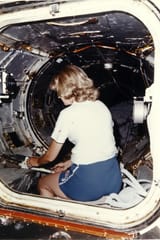Search Results
7/11/2025, 5:23:39 PM
>Nancy Rowe (b. 1941, Oakland, CA) was a systems engineer and materials scientist selected for NASA’s Advanced Payload Integration Team in the late 1960s. With a background in aerospace polymer stability and radiation-hardening, she earned respect as one of the few non-military personnel involved directly in mission design.
>In 1971, Rowe was one of two civilian scientists transferred to astronaut training under the experimental Skylab/Apollo Dual-Track Program, designed to integrate high-value scientific specialists into active mission crews. After intense Lunar Module systems training and EVA conditioning, she was assigned as Mission Payload Specialist aboard Apollo 20 (a continuation of the Apollo Applications Program sanctioned by President Zubrin).
>The NGGR experiment was a cutting-edge geochemical survey technique developed jointly by NASA and Los Alamos National Laboratory. It aimed to:
>Map subsurface mineral composition using low-energy neutron pulses.
>Detect hydrogen-bearing compounds (potentially trapped water, hydroxyls, or volatiles).
>Measure neutron backscatter differentials to identify metallic inclusions or buried regolith anomalies beneath the lunar surface.
>NGGR used a collapsible probe array deployed a few meters outside the LEM, tethered by insulated fiber-optic and thermal lines. Nancy Rowe was responsible for assembling the final emitter gate couplings inside the LEM prior to deployment — a task requiring precision and deep familiarity with radiological safety procedures in low-G.
>In 1971, Rowe was one of two civilian scientists transferred to astronaut training under the experimental Skylab/Apollo Dual-Track Program, designed to integrate high-value scientific specialists into active mission crews. After intense Lunar Module systems training and EVA conditioning, she was assigned as Mission Payload Specialist aboard Apollo 20 (a continuation of the Apollo Applications Program sanctioned by President Zubrin).
>The NGGR experiment was a cutting-edge geochemical survey technique developed jointly by NASA and Los Alamos National Laboratory. It aimed to:
>Map subsurface mineral composition using low-energy neutron pulses.
>Detect hydrogen-bearing compounds (potentially trapped water, hydroxyls, or volatiles).
>Measure neutron backscatter differentials to identify metallic inclusions or buried regolith anomalies beneath the lunar surface.
>NGGR used a collapsible probe array deployed a few meters outside the LEM, tethered by insulated fiber-optic and thermal lines. Nancy Rowe was responsible for assembling the final emitter gate couplings inside the LEM prior to deployment — a task requiring precision and deep familiarity with radiological safety procedures in low-G.
Page 1
